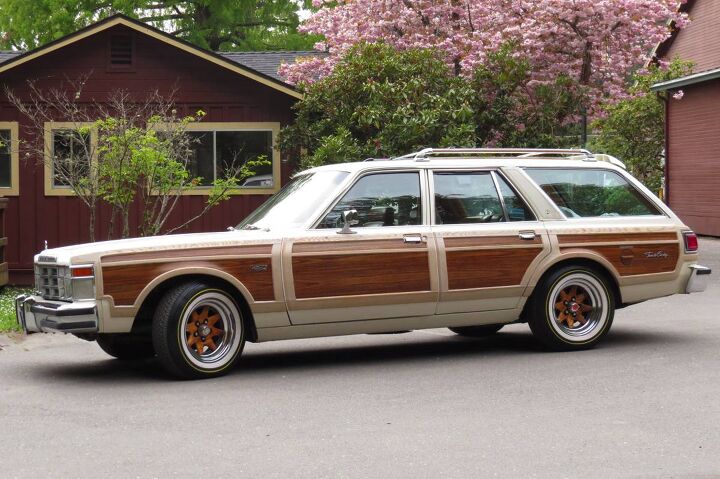Rare Rides: The 1978 Chrysler LeBaron Town & Country Gives You Wood

An aluminum garage door rattles open on its track. As the goldenrod-colored panels lift up and away, a luxurious family wagon comes into view. Once the kids, parents, and Golden Retriever are lightly secured inside, the luxury wagon glides out of the lightly sloped driveway and away from the bi-level with the paneled den.
It’s 1978, and it’s Town & Country time.
A nameplate that started out as a luxurious family wagon all the way back in 1940, the Town & Country wagon began a new, downsized seventh generation for 1978. 1977 was the last time the T&C was on the same scale as its rivals at GM and Ford — Chrysler saw the writing on the wall for fuel prices and the large family wagon. Moving away from the fuselage C-body, the downsized ’78 switched over to the rear-drive M-body.
The M platform was also the basis of the compact Dodge Aspen and midsize Diplomat, and their relatives at Plymouth and Chrysler. Unlike the C-body, the M didn’t have variable wheelbase lengths. This meant the smaller Aspen, the luxurious Fifth Avenue, and the Town & Country were all the exact same size inside, but with different lengths of front and rear overhang. The Town & Country name was applied to the Chrysler LeBaron; the trim played the part of most upscale wagon as it had previously.
Three different engines powered the wagon: a 225 inline-six for the skinflint, or the 318 (5.2-liter) or 360 (5.9-liter) V8s. Power traveled to the rear via a smooth three-speed TorqueFlite automatic — enough gears for any luxury vehicle.
Changing times meant M-body wagons were short-lived at Chrysler, and all of them went away after the 1981 model year. You can see where this is headed. 1982 brought a brand new selection of smaller, four-cylinder, front-drive wagons; the inception of K-car world. In 1990, Town & Country’s transformation took the final turn into Van Life.
Today’s 1978 example comes strong with the wood. The same original owner who specified the largest V8 also went straight from the dealer to a wheel shop, because he needed something more. The factory faux wire wheel covers were tossed, in favor of eight-spoke wood wheels with wood center caps. Judgment of taste level there is up to you, kind reader. The rest of the Town & Country looks in good condition, and with 84,000 miles on the clock asks $7,200.
[Images: seller]

Interested in lots of cars and their various historical contexts. Started writing articles for TTAC in late 2016, when my first posts were QOTDs. From there I started a few new series like Rare Rides, Buy/Drive/Burn, Abandoned History, and most recently Rare Rides Icons. Operating from a home base in Cincinnati, Ohio, a relative auto journalist dead zone. Many of my articles are prompted by something I'll see on social media that sparks my interest and causes me to research. Finding articles and information from the early days of the internet and beyond that covers the little details lost to time: trim packages, color and wheel choices, interior fabrics. Beyond those, I'm fascinated by automotive industry experiments, both failures and successes. Lately I've taken an interest in AI, and generating "what if" type images for car models long dead. Reincarnating a modern Toyota Paseo, Lincoln Mark IX, or Isuzu Trooper through a text prompt is fun. Fun to post them on Twitter too, and watch people overreact. To that end, the social media I use most is Twitter, @CoreyLewis86. I also contribute pieces for Forbes Wheels and Forbes Home.
More by Corey Lewis
Latest Car Reviews
Read moreLatest Product Reviews
Read moreRecent Comments
- KOKing I thought they quit making it 3yrs ago so... no?
- TheEndlessEnigma Hybrids and PHEVs make sense, EV's do not.
- Ajla My understanding is that the 5 and 7-Series cater almost exclusively to the Chinese market and they sell them here just so they don't look weak against Mercedes and Audi.
- EBFlex Interesting. We are told there is insatiable demand for EVs yet here is another major manufacturer pivoting away from EV manufacturing and going to hybrid. Did these manufacturers finally realize that the government lied to them and that consumers really don’t want EVs?
- Kwik_Shift_Pro4X What's worse than a Malibu?








































Comments
Join the conversation
I had the LeBaron sedan of that vintage...nice, comfortable car on trips...even squeezed 15 mpg out of it sometimes. I bought it used with 75 K miles after a divorce. I bought a new 78 Diplomat wagon with 360 and it felt as strong as our 360 powered police Volares, but rode much better. I lost that one in the divorce...my ex drove it to 115 plus thousand miles...spend nothing but maintenance on it. But alas, by 1985, it was engulfed in rust...
Amazing how much better the M-Bodies were overall than the Aspen/Volaré, which looked from the outside to be the same car. Or were things different under the skin?